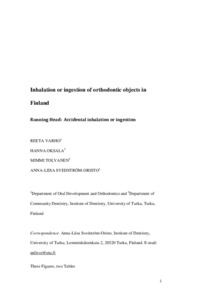Inhalation or ingestion of orthodontic objects in Finland
Varho R; Oksala H; Tolvanen M; Svedstrom-Oristo AL
https://urn.fi/URN:NBN:fi-fe2021042715431
Tiivistelmä
Objectives. Although inhalation or ingestion of orthodontic appliances can lead to serious medical problems, the real incidence of these complications is anecdotal. This study had two aims: (1) to define the frequency of accidental inhalation/ingestion of orthodontic objects in Finland and (2) to analyze their further management. Materials and methods. An electronic, semi-structured questionnaire was sent to all members of the Orthodontic Section of Apollonia, the Finnish Dental Society (n = 251) and the Finnish Federation of Dental Hygienists (n = 437). After one reminder, 55.8% of dentists and 34.8% of dental hygienists responded. Results. In total, 20.0% of the dentists and 6.9% of the dental hygienists reported having one patient who had ingested or inhaled an orthodontic object. The percentages for two or more cases were 18.6% and 6.9%, respectively. According to dentists' answers, the procedures following these complications were (1) observation for 2-14 days (n = 27), (2) radiologic evaluation (n = 14), (3) medical emergency (n = 6) and (4) dietary instruction (n = 4). Dental hygienists reported (1) observation (n = 9), (2) dietary instruction (n = 3) and (3) medical emergency (n = 1). None of the cases had been life-threatening. Conclusions. Although the risk of inhalation or ingestion of orthodontic objects is small and the consequences rarely serious, it should be taken into consideration. Prospective patients should be informed of this possibility.
Kokoelmat
- Rinnakkaistallenteet [27094]
